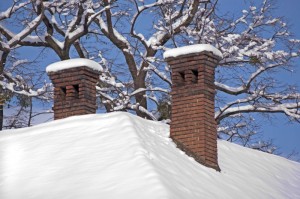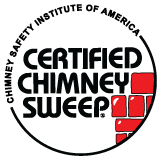Chimney Liner Repair
When most people think about damage to their chimney they think about crumbling mortar and chipped bricks on the exterior of the chimney structure caused by age and weather erosion. While this is something to be concerned about the most common (and the most dangerous) chimney damage happens inside the flue where it cannot be seen without a proper inspection. Cracked and damaged chimney liners are more common than people realize and can put your home and family at great risk if not properly repaired.
How Can I Tell If My Chimney Liner Is Damaged?
 The best, most effective way to tell if you have a damaged chimney liner is a proper inspection by a CSIA certified chimney technician [https://chiefchimney.com/]. A certified tech will run a camera up your chimney so that they can see exactly what state your entire chimney liner is in. If you have a clay tile liner (the most common among older chimneys) the tech will be looking for cracked, broken, or missing tiles.
The best, most effective way to tell if you have a damaged chimney liner is a proper inspection by a CSIA certified chimney technician [https://chiefchimney.com/]. A certified tech will run a camera up your chimney so that they can see exactly what state your entire chimney liner is in. If you have a clay tile liner (the most common among older chimneys) the tech will be looking for cracked, broken, or missing tiles.
When you burn a fire the chimney heats up and cools down rapidly causing stress on the clay tiles. Over time these tiles will fracture and break and can even fall off completely. When this happens it leaves a gap in the liner exposing the masonry structure to the heat and combustible byproducts of a wood burning fire. This can cause major structural issues for your chimney and can create a potentially hazardous situation for you and your family.
If My Liner Is Damaged What Are My Options?
If your chimney liner is cracked or damaged your chimney sweep will know what to do next. Depending on the severity of the damage a relining job [https://chiefchimney.com/chimney-repairs/chimneys-relined/] might be necessary. In many cases this is the best option regardless. If your chimney liner is starting to show signs of wear and tear it will eventually have to be replaced. It is better to have that done at the first sign of an issue otherwise you are simply prolonging the inevitable and spending money on small repairs in the process. Your specific chimney system will dictate what type of liner to have installed but in most cases HeatShield is the way to go.
What is HeatShield?
HeatShield [http://cecurechimney.com/heatshield-system.html] is a Cerfractory Flue Sealant product that is used to either repair or completely replace your chimney liner. It is one of the most trusted products in the chimney industry and comes with a 20 year material warranty. There are 2 methods of using HeatShield to repair a damaged chimney liner.
Resurfacing – If the damage to a chimney liner is not too extensive the chimney sweep may recommend using the HeatShield resurfacing system. This process is performed in several steps. The first step involves a “tie-coat” that cleans the interior of the chimney liner of dust and debris and acts as a primer for the final HeatShield application. Once this primer has dried the HeatShield material is applied into the flue at ¼ inch thickness. After this is all finished a camera is run up the length of the chimney to ensure that there are no gaps left in the liner.
CeCure Sleeve Relining – If the chimney liner is extensively damaged or missing all together your chimney sweep may recommend completely relining your chimney. This is where the CeCure Sleeve Relining system comes in. When installing a CeCure Sleeve Relining system the first step is to coat the interior of the chimney with a coating of HeatShield Cerfractory Flue Sealant and a drying accelerator. Next a custom fitted CeCure Sleeve is lowered into your chimney and secured to the top of your system. This sleeve provides ceramic insulation and is reinforced with stainless steel fabric. Once this is in place another coating of the Flue Sealant is applied and another camera is run to ensure that everything is in place properly.
How Do I Schedule A Chimney Inspection?
If you have a fireplace and chimney you should have a chimney inspection performed annually by a CSIA certified chimney technician. Call Chief Chimney Services today to schedule your appointment or visit us online at chiefchimney.com.





